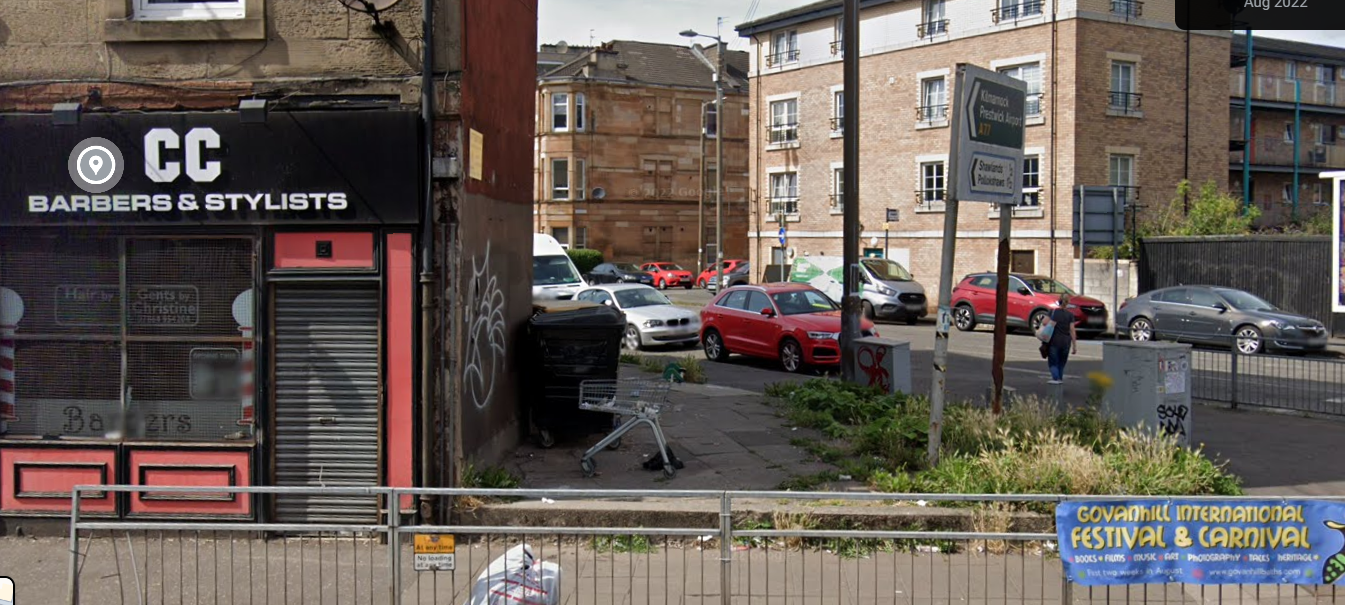Duncan Brown (1819-1897) was a talented amateur photographer who documented Glasgow life from the 1850s onwards. This undated photograph from the Glasgow School of Art Archives features on TheGlasgowStory, and depicts Nithsdale Street from Allison Street, across Pollokshaws Road . For orientation, Heraghty’s pub & CC Barbers would be just to the left out of shot, and Strathbungo Station/Susie’s shop (alas no more) are in the far distance.
The photo has appeared here before, but it suddenly made more sense when rummaging in the valuation rolls for Nithsdale Street. Here’s a closer look.
2 Nithsdale Street
The house on the right carries a sign for Robert Bryce, Plumber & Gasfitter. It was variously numbered 2 Nithsdale Street, or 694 Pollokshaws Road, and abutted the tenement that now houses Glasgow Photo Express and Koelschip Yard. It was Robert’s workshop from 1893 to 1900, which helps date the photograph.
Robert was the son of John Bryce, whose plumbing business was in Oswald Street. They lived at 140 Mains Street (now Blythswood Street), which seems quite a posh address for a firm of plumbers. In 1883 Robert married Agnes, daughter of master mason John McCaa, and they had five daughters and a son. By 1891 Robert was head of the household at Mains Street. The family moved to Abbotsford Place in the Gorbals, and later to Albert Road in Crosshill, while from 1893 he had his work premises here on Nithsdale Street.
His presence in Strathbungo was relatively short lived however – he died in 1900, in his early 50s, of influenza. He was outlived by his father, who had retired to Dunoon where he died two years later.
The house didn’t fare any better. It was absent on a planning application dated 1899, so presumably had already been demolished, probably as part of a widening and realignment of that end of Nithsdale Street, and perhaps in relation to laying of tramlines for the number 12 route.
Next door was a small house set back out of sight, occupied by Elizabeth Macpherson, and beyond that a coal ree and stable managed by Francis Davidson, a coal dealer. All these buildings were owned by the Cathcart District Railway Company, that had laid the western arm of the Cathcart Circle line through Strathbungo in 1893-4. Macpherson’s house was over the railway line. Maps show a further building that stuck out into Nithsdale Street at the corner of March Street that would also have needed to go for the tram lines. In 1895 this plot was vacant. I wonder if the pile of timber in the picture has resulted from its demolition.
The subsequent use of these plots was as a motor garage – but that’s for another story.
7 Nithsdale Street
The house on the left is mostly hidden by large advertising hoardings. This appears to be 7 Nithsdale Street, a house which lasted somewhat longer – it was present on maps of the mid 1930s, but gone by the 50s. The outline of the building still exists if you look for it – you may even have walked over it.
It was owned by Cathcart District Railway Co in 1895, but by the Corporation of Glasgow Police Department in 1905. The tenant remained Arthur Wright, a carter, until at least 1920, and thereafter one William Denver, an engine driver. I had presumed the site still belonged to the council, though I am subsequently told it belongs to the owners of Heraghty’s Bar.
On the left edge of the photograph is a lean-to shop, probably a confectioner, on the Pollokshaws Road frontage of the house. This appears intermittently in the records as 700 Pollokshaws Road. Jessie Greenlie was there as a fruitier in 1895. The shop in the tenement next door at No 704 was that of Archibald Caldwell, another plumber and gasfitter, and lead merchant, and later another gasfitter, William Norris & Son. The Glasgow chain of A & J Morrice, newsagents and confectioners, set up a branch in the lean-to circa 1930.
In March 1935 a photograph shows A & J Morrice having extended into 704 with a new shop front, displacing Norris the plumbers.

A & J Morrice, newsagents and confectioners at 704 & 700 Pollokshaws Road. They had other branches in the city. Sou704rce: Glasgow City Archives D-CA8/2460
The pub to the left was originally The Golden Star. Michael Heraghty only took over the pub when his previous pub, The Garryowen, was slated for demolition in the Gorbals clearances in 1972 . He preserved the frontage, thankfully.
Advertising hoardings
The name at the top of the advertising hoarding on the left is Beith’s, West Howard Street. This was Robert Beith, bill poster. It doesn’t sound very glamorous but “director of advertising agency” might be the modern equivalent. He lived in Kilmacolm, and later St Ronan’s Drive in Shawlands. His son John was also in the business. They moved from West Howard Street to Hope Street around 1896, further dating the photo to 1893-6.
The hoarding on the right was let to John MacDonald & Son, another billposting firm. Both sites were owned by the railway.
Some of the advertisers can be identified.
T&H Smith were an Edinburgh pharmaceutical firm who were the first to develop a liquid essence of coffee, as advertised here, but they made their fortune by developing injectable morphine.
Paterson’s rival coffee essence is also advertised. This became Camp Coffee and is still sold today.
Courtenay’s Worcestershire Sauce was an imitation of the Lea & Perrins original, while Brand & Mollison were a Glasgow dry cleaning firm.
The advert on the right is probably for John Gray & Co’s “famed marmalade”. Founded in the 1860s, their factory was on Adelphi Street, now between Gorbals Sports Centre and the River Clyde. Judging by their advert, it was quite a factory.
So there you have it, the story of two wee Strathbungo houses that are long gone.
Additions and corrections are welcome.







Leave a Reply